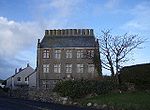Piel railway station
1846 establishments in EnglandDisused railway stations in CumbriaFormer Furness Railway stationsFormer buildings and structures in Barrow-in-FurnessRailway stations in Great Britain closed in 1936 ... and 2 more
Railway stations in Great Britain opened in 1846Use British English from March 2017

Piel railway station was the terminus of the Furness Railway's Piel Branch in Barrow-in-Furness, England that operated between 1846 and 1936. Located on Roa Island it was built to serve the passenger steamers at Piel Pier. The Roa Island causeway was specifically constructed for the railway, in turn making the island part of the British mainland. The station and the Piel Branch line have both been demolished, however the Roa Island Hotel which was built adjoining the station survives to this day as a Grade II listed building.
Excerpt from the Wikipedia article Piel railway station (License: CC BY-SA 3.0, Authors, Images).Piel railway station
Piel Street,
Geographical coordinates (GPS) Address External links Nearby Places Show on map
Geographical coordinates (GPS)
| Latitude | Longitude |
|---|---|
| N 54.0749 ° | E -3.1752 ° |
Address
Piel
Piel Street
LA13 0QJ
England, United Kingdom
Open on Google Maps







